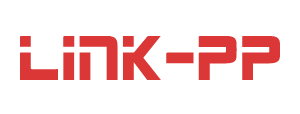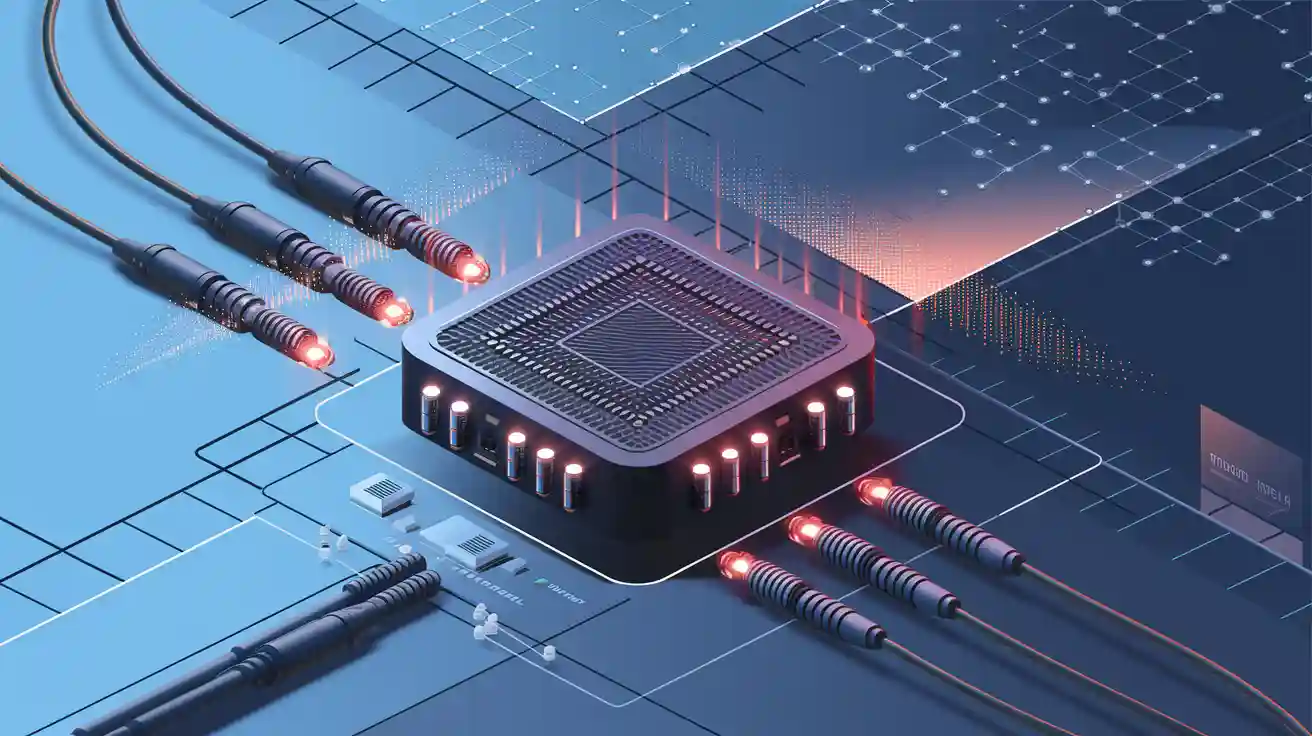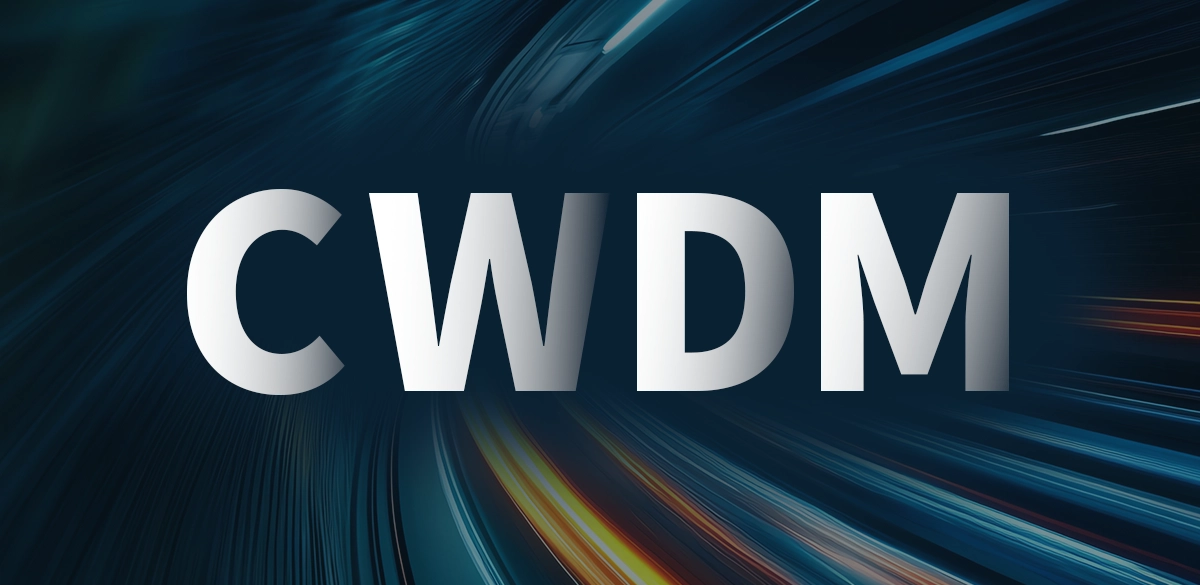
In today's data-driven world, network operators constantly grapple with the challenge: How do you cost-effectively increase bandwidth over existing fiber infrastructure? The answer often lies not in laying more fiber, but in utilizing the existing strands more efficiently. Enter Coarse Wavelength Division Multiplexing (CWDM), a powerful and accessible optical networking technology. But what exactly is CWDM, and why does it matter for your network?
➽ Key Takeaways
CWDM lets many data signals move together on one fiber. It does this by using different light wavelengths that are 20 nanometers apart.
It saves money and energy because it uses uncooled lasers and passive parts. This makes it great for city and campus networks.
CWDM can support up to 18 channels. It works well for distances up to 80 kilometers. You do not need to install new fiber.
The system uses mux/demux units and optical transceivers. These help combine and separate signals. This makes it easy to grow and change the network.
CWDM costs less and is easier than DWDM. But it has fewer channels and works for shorter distances. It is best for medium-speed and moderate-distance networks.
➽ Understanding the Core Concept: What is CWDM?
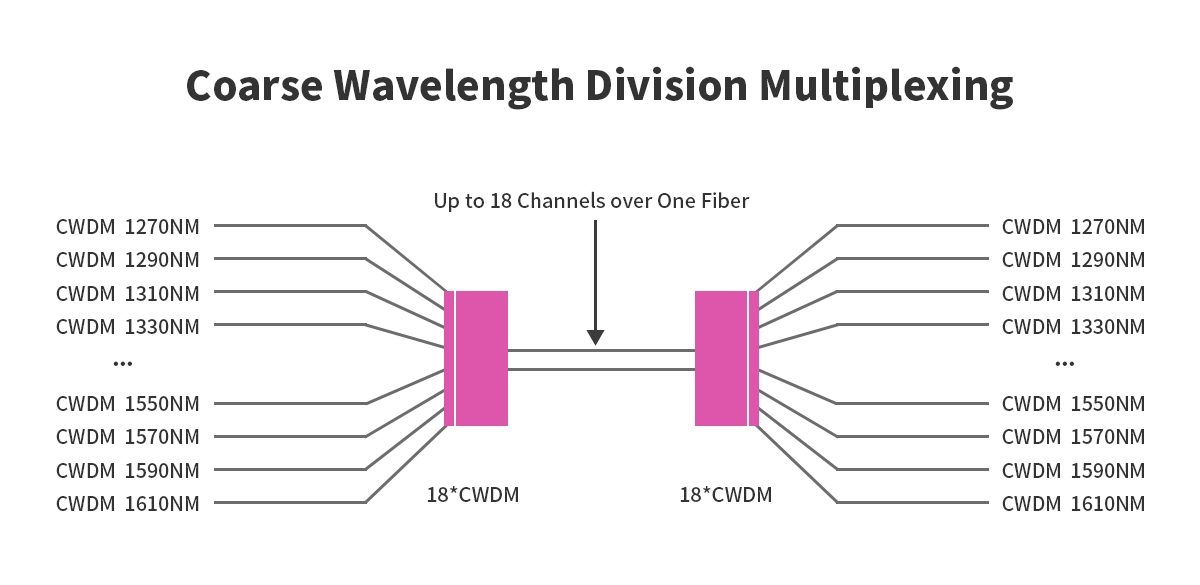
Imagine a multi-lane highway. Instead of sending all vehicles down a single lane causing congestion, multiple lanes allow simultaneous traffic flow, vastly increasing throughput. CWDM operates on a similar principle for optical fiber.
CWDM is a technology that enables multiple optical signals (each carried by a different wavelength, or "color," of laser light) to be transmitted simultaneously over a single optical fiber. Each wavelength acts as an independent channel, carrying its own data stream. The term "Coarse" refers to the wider spacing between these wavelengths compared to its cousin, Dense Wavelength Division Multiplexing (DWDM). Standard CWDM uses 18 wavelengths defined by the ITU-T G.694.2 grid, spaced 20 nanometers (nm) apart, typically within the 1270nm to 1610nm range (though the most commonly used are between 1470nm and 1610nm).
CWDM is part of a bigger group called wavelength-division multiplexing, or WDM. WDM means sending many signals over one fiber by using different wavelengths. CWDM is special because it uses uncooled lasers and wider channel spacing. This design saves power and lowers costs. CWDM works best for distances up to 80 kilometers. It is great for city networks, campus links, and access networks.
➽ How CWDM Works: The Essential Components
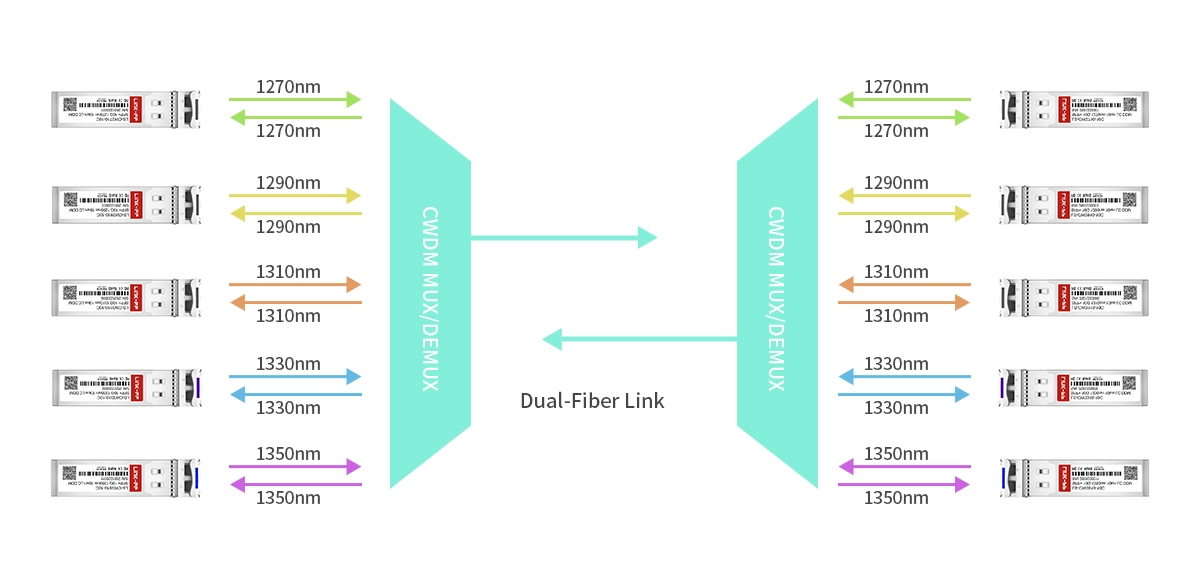
A basic CWDM system involves these key elements:
CWDM Transmitters (Lasers): Located at the transmitting end, each signal source (e.g., a router, switch, or server) is connected to an optical transceiver module. This module emits a laser beam at one specific CWDM wavelength.
CWDM Mux (Multiplexer): This passive device combines (multiplexes) all the individual optical signals, each on its unique wavelength, onto a single outgoing fiber strand. Think of it as the on-ramp merging all the wavelength-specific lanes onto the main fiber highway.
Optical Fiber: The single strand carries the combined multi-wavelength signal over distances, ranging from a few kilometers up to 80km or more, depending on the transceivers and fiber quality.
CWDM Demux (Demultiplexer): At the receiving end, this passive device performs the reverse function. It separates (demultiplexes) the combined signal back into its individual wavelengths. Think of it as the off-ramp splitting the highway back into individual lanes.
CWDM Receivers (Photodetectors): Each separated wavelength is directed to its corresponding optical transceiver module at the receiving end, which converts the optical signal back into an electrical data signal for the destination equipment.
➽ Key Advantages of CWDM Technology
Cost-Effectiveness: This is CWDM's biggest strength. The wider channel spacing allows for:
Less expensive, uncooled lasers in the optical transceiver modules.
Lower-cost filters in Mux/Demux units.
Reduced overall system complexity.
Increased Fiber Capacity: Instantly multiply the capacity of a single fiber pair (transmit and receive) by 8, 16, or 18 channels, depending on the system design. This defers or eliminates costly new fiber installation.
Simplicity & Reliability: Passive Mux/Demux devices require no power and have no active components, making them highly reliable and easy to deploy. Using pluggable optical transceiver modules simplifies installation and maintenance.
Transparency: CWDM is protocol and bit-rate independent. It can carry Ethernet (1G, 10G, 25G), SONET/SDH, Fiber Channel, CPRI, and other services simultaneously over the same fiber.
Low Power Consumption: Primarily passive components and uncooled transceivers result in significantly lower power draw compared to DWDM systems.
Scalability: Start with a few channels and add more wavelengths as your bandwidth needs grow, simply by adding new transceivers and potentially upgrading the Mux/Demux.
➽ CWDM vs. DWDM: Choosing the Right Tool
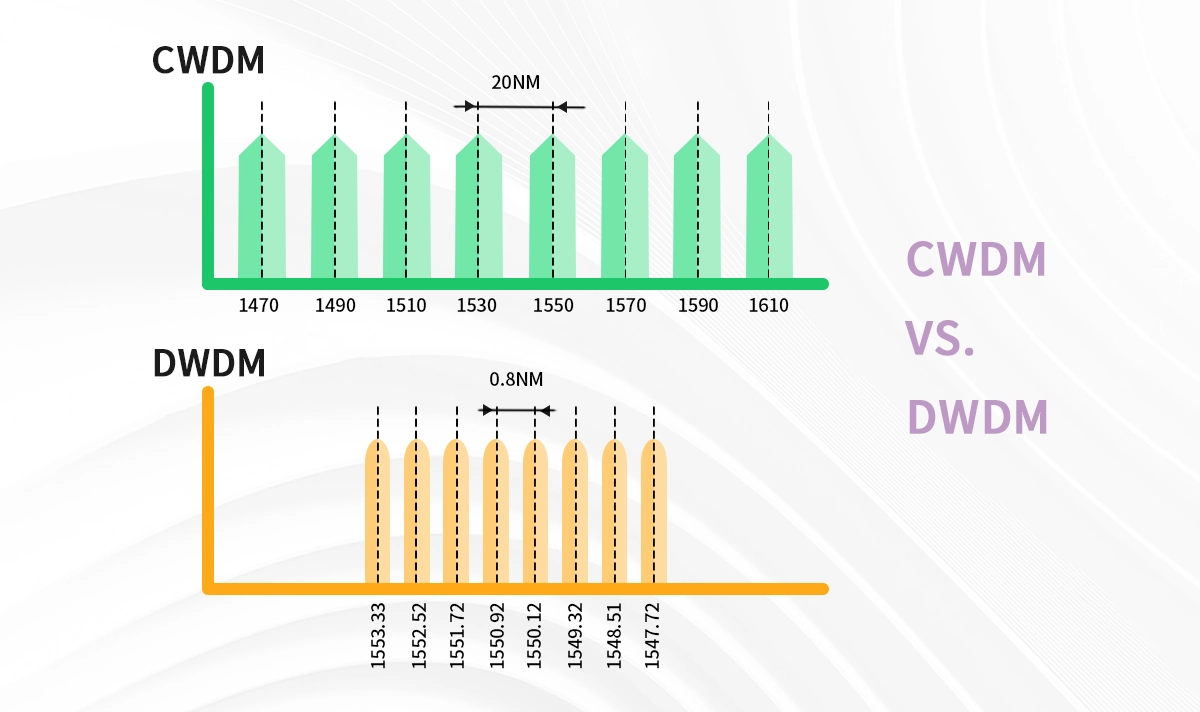
While both multiplex wavelengths, key differences dictate their best use cases:
Feature | CWDM | DWDM |
|---|---|---|
Channel Spacing | 20nm | 0.8nm, 0.4nm (or less) |
Number of Channels | Up to 18 (1270-1610nm) | 40, 80, 96, 120+ (C-band: ~1530-1565nm) |
Laser Type | Uncooled DFB (Lower Cost) | Temperature-Cooled DFB (Higher Cost, Precision) |
Cost | Lower (Transceivers & Mux/Demux) | Higher |
Power Consumption | Lower | Higher (Due to cooled lasers & amps) |
Reach | Typically up to 80km | Hundreds to Thousands of km (with amps) |
Best Suited For | Metro Access, Enterprise Networks, Short-Mid Haul, Cost-Sensitive Capacity Boost | Long-Haul, Ultra-High Capacity, Metro Core |
➽ Use Cases: Where CWDM Shines
CWDM is exceptionally well-suited for numerous applications demanding cost-efficient capacity expansion:
Enterprise Network Backbone Expansion: Connecting buildings or data centers across a campus or city without new fiber.
Mobile Fronthaul/Backhaul (xHaul): Aggregating traffic from multiple cell towers to the central office or controller.
Cable Television (CATV) Networks: Combining broadcast video and DOCSIS data services.
Metro Ethernet Access Networks: Providing high-bandwidth services to business customers.
Data Center Interconnects (DCI): For shorter links (sub-80km) between nearby data centers.
Protocol Aggregation: Transporting mixed services (Ethernet, Storage, Legacy TDM) over a single fiber pair.
➽ LINK-PP: Your Partner for CWDM Optical Solutions

Selecting high-quality, reliable optical transceiver modules and passive components is crucial for optimal CWDM network performance and longevity. LINK-PP offers a comprehensive range of standards-compliant CWDM solutions designed for robustness and value.
High-Performance CWDM SFP, SFP+, XFP, QSFP+ Optical Transceivers: Supporting data rates from 1G to 100G, optimized for various reaches. For example, the LINK-PP LS-CW471G-20C transceiver delivers 1.25G connectivity over up to 20km on the 1470nm wavelength. Need 10G? Consider the LINK-PP LS-CW5710-40C for robust 40km reach. Request Samples ➡
CWDM Mux/Demux Modules: High-isolation, low-insertion loss modules available in various channel configurations (2, 4, 8, 9, 16, 18 channels) in 1U rackmount, LGX, or standalone box form factors.
CWDM OADMs (Optical Add-Drop Multiplexers): For adding or dropping specific wavelengths at intermediate points without terminating the entire link.
Finding the Right CWDM Optical Transceiver Module
When sourcing CWDM optical transceiver modules, ensure compatibility and consider specifications like wavelength, data rate, reach (e.g., 40km, 80km), connector type (typically LC duplex), and operating temperature range. Partnering with a reputable supplier like LINK-PP guarantees interoperability and long-term support.
➽ Conclusion: Unlock Your Fiber Potential with CWDM
CWDM technology remains a vital and highly practical solution for maximizing the utilization of existing fiber optic infrastructure. Its compelling combination of significant capacity gains, inherent cost-effectiveness, operational simplicity, and protocol flexibility makes it an indispensable tool for network engineers tackling bandwidth challenges in enterprise, metro access, and service provider environments.
Ready to explore how CWDM can solve your bandwidth constraints?
Browse our extensive portfolio of high-quality CWDM optical transceiver modules. Visit the LINK-PP website ➦
Design the most efficient and cost-effective CWDM solution tailored to your specific network requirements. Contact our technical experts ➦
Don't let fiber capacity limit your growth – unlock the potential with CWDM and LINK-PP!
➽ See Also
Understanding WDM Technology And Its Uses In Optical Networks
